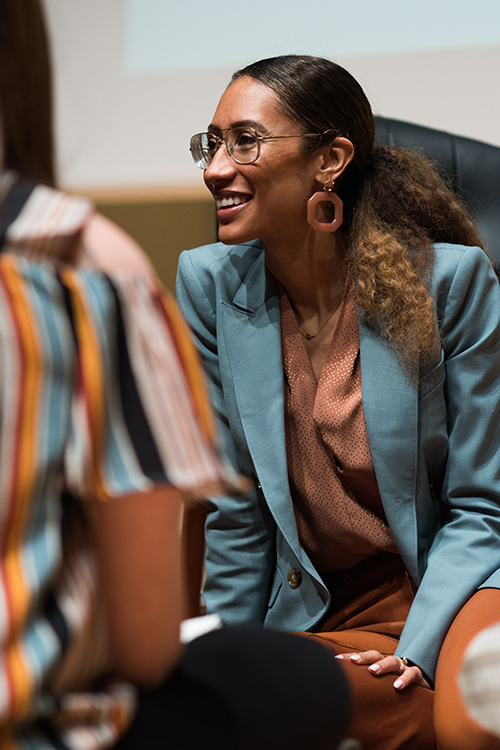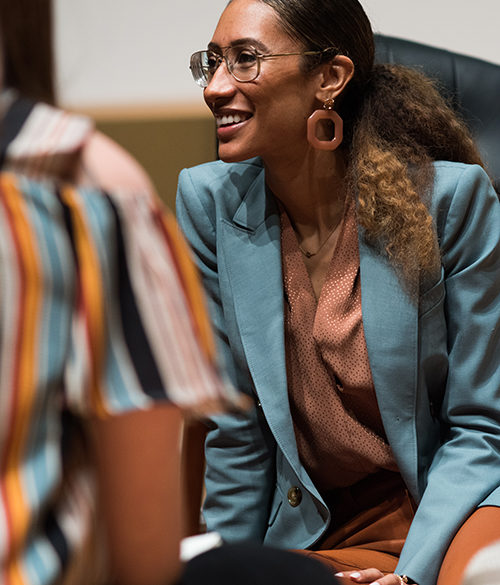In her time as editor-in-chief of Teen Vogue, Elaine Welteroth aimed to create diverse coverage that touched on all aspects of what it means to be a young person.
At 29 years old, Elaine Welteroth became the youngest editor-in-chief in Condé Nast history when she was chosen to lead Teen Vogue. Under her guidance, Teen Vogue began to focus its coverage on politics and social issues. At 31 years old, the fashion mogul left her position with the magazine to add more diversity and social justice activism to her résumé. Ball Bearings sat down with Welteroth to gain a better understanding about her views on activism and how she earned the reputation she proudly wears today. Here’s what she had to say.
Ball Bearings: What do newsrooms get wrong when they cover activism?
Elaine Welteroth: You can use your platform to uplift the voices of youth activists, and I think that’s something that’s really important at a time like this. No one can reflect the issues that matter to young people and the reasons they matter to young people better than young people themselves. I think for too long, there hasn’t been a mainstream media platform that creates a collective youth voice that can help inform young people about the issues that affect them and actively depict what young people care about. I think that’s really what Teen Vogue was striving to become. I think we are all stronger together. It’s hard to occupy siloes all over the country and work in local grass root organizations, but I think it’s equally important to create platforms that amplify those voices and the work they are doing to create more impact.
BB: What opportunities have opened up for women as a result of activism in the past five, 10 years?
EW: We’re talking about diversity, inclusion, women’s empowerment, and the imbalance of power in more ways and in more spaces than ever before. I still think we have a long way to go, but at least these issues are being brought to the light. I think the result has been more conscious and courageous conversations that have elevated everyone’s awareness. Hopefully we will see more shifts in business practices and among the people who make decisions across industries.
The one thing we cannot afford to do is treat these issues like trends. Every institution and every power structure needs to make sure these issues are being addressed. It took generations for us to get here, and it’s going to take us generations to really solve these problems.
I’m really excited about the changes I’ve seen in the publishing world. I think my hire reflected a seat change of sorts. The new editor-in-chief is also a young black woman, and I’m really happy about that. The industry has taken risks, and we are all realizing that you don’t have to be a 50-year-old white man to make smart business decisions. If anything, I think younger, more diverse leadership brings more creative, innovative ideas.
BB: What made you want to enter the journalism world?
EW: I’ve always loved magazines. I was a magazine junkie as a kid. But I didn’t think that career path was possible. I came from a super small town where no one dreamed of moving to New York, so big dreams never seemed realistic to me. I never even looked at a masthead until I was in college and having my pre-quarter life crisis.
I think it’s really important for young people to figure out what you don’t want to do. That helps you realize what it is you’re meant to do. When I was in that spiral of trying to figure out what I was going to do with my life, I returned to all the things I loved doing for free.
I find a question like What is your passion? extremely overwhelming. As a college student, it was my least favorite question. But if you reframe that and ask, What do you do for free that would be amazing to get paid for? I went back to my childhood years, and I said I love magazines. I love storytelling. I love creating photo albums. And that sounds crazy: Nobody is going to pay me to make a photo album. But guess what a magazine is? The most epic photo album.
I actually got an opportunity in my photojournalism class to pitch a story idea to a national magazine. And the deal was, if you could place a story in a national magazine, you would get an automatic “A,” and you never have to come back to class again. And I thought, That’s how to motivate a college student. I’m going to get this thing placed. And I did.
The high of dreaming up an idea, pitching it to the editor, getting her to say yes, being on deadline, submitting the piece, and then seeing my name in print—that creative process just lit me up. I got addicted.
I pitched her again, and I got published again. Then I went off to New York for an advertising industry internship, which I felt was a safer path. This was at the beginning of the recession, so I was trying to have a stable future.
But I hated that internship so much. I remember one night I was having an off-the-record conversation with another intern, and we were talking about how much we hated the internship. We didn’t feel excited about coming to work. He said he wanted to be a journalist, and I said I did too. I told him about my clips that I was excited about, and he said it wasn’t journalism because it was about fashion and beauty in a women’s magazine. I challenged this guy, and we fought it out until about midnight.
I stood up for my work, and I argued with him about how sexist it was to tell me that. At the end of the night, when I won the argument, I realized this is what I should be doing. If I cared this much about this thing, I should be doing this.
So I found an editor online and read her bio. I saw that she had been a magazine editor for 11 years before becoming a best-selling author. She had a television platform and was able to cultivate herself across multiple mediums while telling important stories.
I thought, This is what I want to do. I see myself in this woman. I have to meet her. Long story short, she hired me five months later, and it was sort of a Cinderella career story. I didn’t know anyone in the industry. I got lucky, but I was prepared for that opportunity once it came, and the rest is history.
You have to chase the thing you are most passionate about. It will be hard, but you can figure it out. I think the most important thing is to do what only you can do. Do the thing that makes you feel the most alive. For me, that was telling stories.
BB: What have you learned about up-and-coming young people?
EW: They are underestimated. I think there are so many misnomers about young people being apathetic, selfie-obsessed, Kardashian-obsessed, or Kylie Jenner-obsessed. But the reality is that we can be many things. We contain multitudes.
With Teen Vogue, we really wanted to create this intersectional platform that celebrated all aspects of our identities as young people who care about the world but also care about makeup. We wanted to make sure we didn’t shame anyone for any one aspect of their personalities or identities. I think it’s safe to say that before Teen Vogue, most people were not considering the youth perspective as it relates to news, politics, and activism. At least nowhere near as much as they are now. I’m really glad to see that shift because this is the largest, most diverse, most socially conscious, most politically-active, and most informed generation of young people in history. To underestimate them is a huge mistake and a huge missed opportunity.
BB: Why is diversity so important to you, especially in the entertainment industry?
EW: There are a million things I could say to answer that question.
The reality is that a diverse newsroom, like a diverse staff in any industry, is going to be more creative, innovative, and effective. Data supports that on a business level.
But I think on a personal level, I know what it’s like to be the only one. It isn’t easy. Part of the responsibility that comes with being the first, the only, or the youngest is to make it easier for the next.
I know it was hard for me to see myself in this role when I didn’t have any role models that looked like me and came from where I came from. I had to kind of rewrite some of my own rules to navigate that world. I think it’s important that, as we rise, we’re lifting those around us as we go.
At Teen Vogue, it was crucial for us to focus on building a diverse staff because we wanted to reach a diverse audience. That’s the quickest way to do that authentically: to make sure those people we’re trying to reach are reflected in the voices at the table where decisions are made.
Representation matters. Authentic representation matters even more. Diversity and inclusion are critical in any newsroom, but especially in a newsroom that targets young people.
We couldn’t just change the covers and the headlines. We had to change the storytellers.




